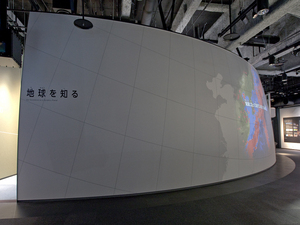Nagoya City Science Museum
TOP > Exhibition Guide > Keyword Search > Starting with "G" > Global Warming > The Frontiers of Science - Future Challenges -
The Frontiers of Science - Future Challenges -



Purpose of Exhibition
Research to acquire knowledge of our global environment is being actively pursued. It is necessary to study the mechanism of the universe and beneath the surface of the earth to understand the global environment. This exhibition is a simple prologue to find out how those scientists and engineers carry out their difficult research, which leads to opening up the future.
Additional Knowledge
[Understanding Global Environment] When talking about "global environment", it usually indicates the "surface environment on earth". Taking a look at one five hundred thousandth cross-section of the earth, you will realize just how narrow the surface environment of earth is. On the other hand, you can understand how vast space and underground of the earth is. It will make you feel like the surface environment of the earth is merely a boundary between two huge environments (the universe and underground). It can be said that this section is a place where substances in the universe and underground environment and energies are exchanged. Therefore, if understanding about the universe and the underground is accelerated, it may help to resolve global environment issues. Not only that, there is a possibility that it will lead to creating new technology that will help develop our human society by making use of distinctive environments. In order for us living on the surface environment of earth to nurture an affluent lifestyle for the future, we should aim to understand both the universe and the underground environment and make full use of every possible technology. It must be the frontier of science. Currently, the frontiers on which a large number of scientists and technicians are cooperating together and tackling, are the interpretation and utilization of the global environment and phenomena taking place there.
[Space Environment] Space environment has almost no gravity, is high-vacuum, and has strong radiation. It is not an environment where living things we know can survive. On the other hand, research and experiments from various fields can be conducted by making use of the environment that does not exist on the surface of our earth. Gravityless condition enables light and heavy things to mix easily and to grow crystals without generating convection. Using this, the advancement of new technology such as development of new materials and medicine, and advancement in the field of medicine concerning the environmental effect of the universe on creatures and humans is expected. Scientists, using the international space station and earth observation satellites, intend to carry out astronomical and earth observation in airless space and aim to understand the environment of space and the underground. [Underground Environment] Although the underground environment is right below us, it remains unexplainable. The underground environment is mainly made of rocks and ground water. The deeper the underground goes, the higher its pressure becomes. It is characterized by the lack of oxygen there (state of reducing condition). Since light is not able to go through, it is invisible. You may think it could be visible if digging a tunnel. But pressure is freed and air rushes in, and it no longer keeps the original condition of underground environment. Recently, interest in underground environment such as soil pollution caused by waste disposal and land subsidence has been growing. It is necessary to study the slow changes deep inside of the earth so as to understand the global environment in the long run. Scientists are aiming to understand the underground environment through direct observation of substances by deep drilling and indirect speculation by seismic waves.
Article by Shoji Nishimoto, curator
